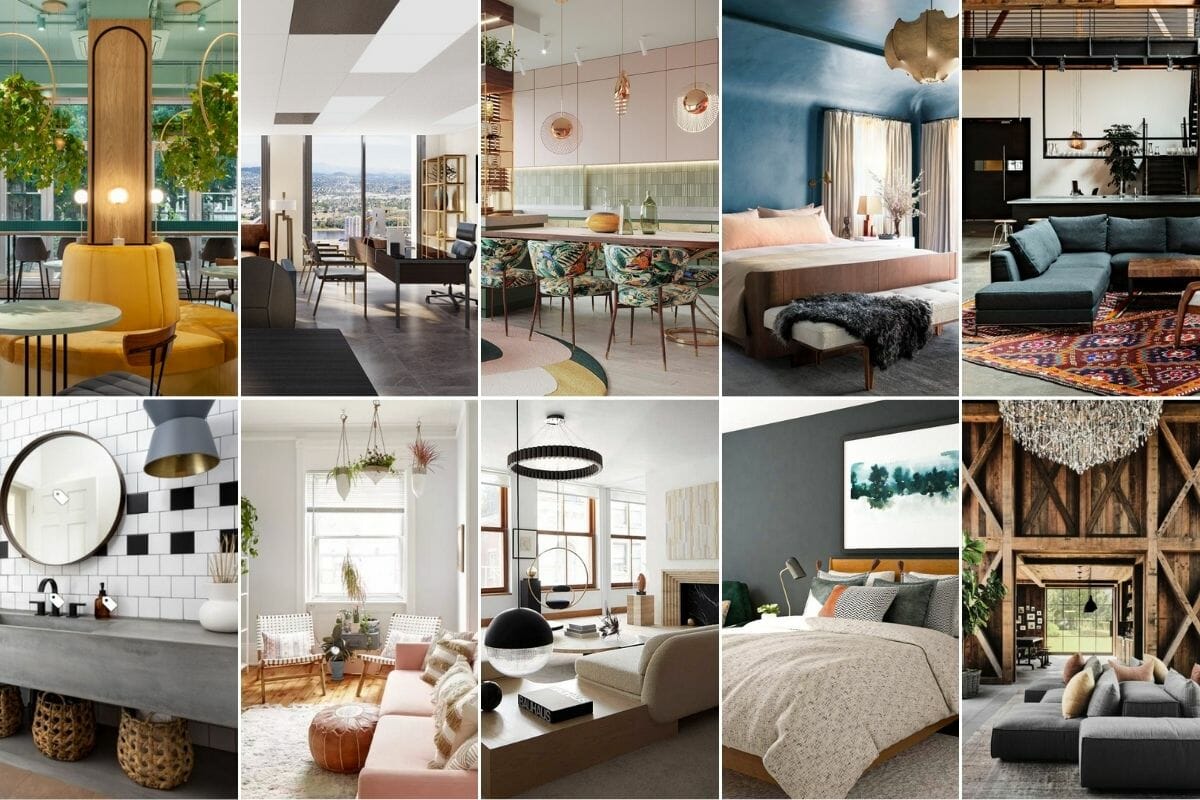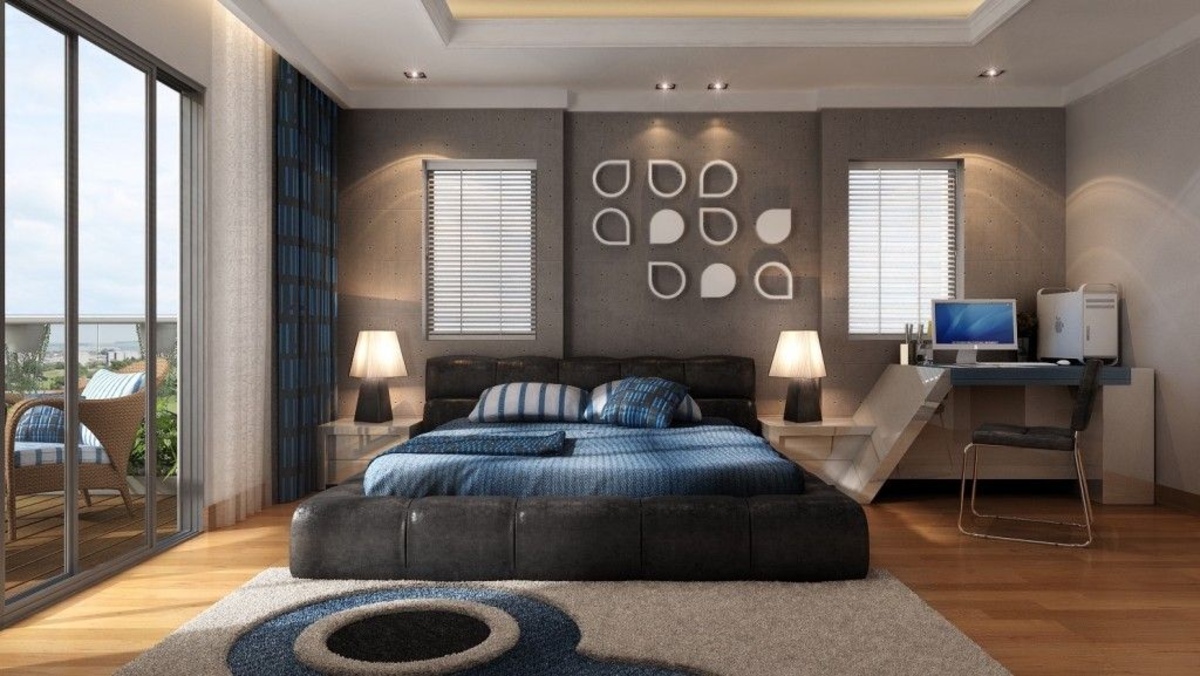Home>Interior Design>Where Do Designers Get Inspiration From? We Asked The World’s Best Designers


Interior Design
Where Do Designers Get Inspiration From? We Asked The World’s Best Designers
Modified: January 6, 2024
Discover where the world's best interior designers find inspiration and unleash their creative genius. Explore their secrets and elevate your interior design game.
(Many of the links in this article redirect to a specific reviewed product. Your purchase of these products through affiliate links helps to generate commission for Storables.com, at no extra cost. Learn more)
Where do designers get inspiration from? We asked the world’s best designers
Introduction
In the ever-evolving world of interior design, creativity and innovation often go hand in hand. Designers continuously strive to create unique and captivating spaces that reflect their clients’ personalities and desires. But where do these talented individuals find their inspiration? What drives their creative process? To answer these questions, we reached out to some of the world’s most renowned interior designers for insights into their sources of inspiration.
Design inspiration can come from a multitude of sources, ranging from nature and art to personal experiences and cultural references. It is a subjective and deeply personal aspect of the creative process. However, by understanding where designers derive their inspiration, we can gain a deeper appreciation for their work and perhaps even find inspiration ourselves.
In this article, we will explore the various sources of inspiration that designers draw upon to create incredible spaces. We will delve into the realms of nature, art, architecture, fashion, technology, and more. By examining these different sources, we hope to provide you with a comprehensive understanding of the world of design inspiration.
Furthermore, we will share insights from interviews with some of the industry’s most esteemed designers. Their perspectives and experiences will offer valuable glimpses into the creative minds that shape the world of interior design.
Whether you are a budding designer, a homeowner looking for inspiration, or simply someone curious about the creative process, this article is for you. So, join us as we uncover the secrets behind the artistic minds of the world’s best designers.
Key Takeaways:
- Designers draw inspiration from nature, art, architecture, fashion, and personal experiences, creating captivating and emotionally resonant spaces that reflect their clients’ identities and aspirations.
- Collaboration, sustainability, and a deep connection to personal experiences and cultural influences drive the creative process of world-class designers, shaping extraordinary and meaningful interior spaces.
Understanding the Role of Inspiration in Design
Inspiration is the fuel that drives the design process and sparks innovative ideas. It serves as a catalyst for creativity, pushing designers to think outside the box and reimagine what is possible. Without inspiration, design would be stagnant, lacking the vitality and freshness that captivates our senses.
Designers seek inspiration to ignite their creative instincts, to challenge conventional norms, and to bring uniqueness to their work. It is through inspiration that designers inject their personality and vision into their designs, creating spaces that tell a story and evoke emotions.
Moreover, inspiration breathes life into the design process by giving designers the courage to experiment and take risks. It encourages them to step out of their comfort zone and explore new approaches, materials, and techniques. Designers understand that without inspiration, their work would lack depth and meaning, becoming just another mundane creation.
Design inspiration is not limited to a one-time occurrence. It is an ongoing, ever-evolving process that demands constant nourishment and exploration. Designers actively seek out sources of inspiration to keep their creative juices flowing, to stay relevant in an ever-changing industry.
It is important to note that inspiration is not about copying or imitating. Rather, it serves as a starting point, a springboard from which designers can develop their unique concepts. It is the foundation upon which they build their design narratives, incorporating their personal style, client requirements, and functional aspects.
Ultimately, inspiration is the soul of design. It is the intangible element that distinguishes exceptional design from ordinary ones. It is the invisible thread that connects the designer’s vision with the final result, creating spaces that resonate with beauty, functionality, and emotional impact.
Exploring Different Sources of Inspiration for Designers
Designers find inspiration in a vast array of sources, drawing from the world around them as well as their own unique experiences. Let’s take a closer look at some of the key sources of inspiration that shape the creative process:
-
Nature and the Environment
The natural world is a never-ending source of inspiration for designers. From the intricate patterns found in flora and fauna to the soothing color palette of a sunset, nature offers a wealth of ideas to explore. Designers often draw elements such as textures, shapes, and colors from the environment, bringing the beauty of the outdoors into interior spaces.
-
Art and Artists
Art has long been a source of inspiration for designers. Paintings, sculptures, and other forms of art can ignite the imagination and provide a fresh perspective on design. Artists themselves, with their innovative techniques and unique expressions, can serve as inspiration for designers seeking to push boundaries and create truly extraordinary spaces.
-
Architecture and Structures
Architecture is a natural source of inspiration for interior designers. The shapes, materials, and spatial arrangements seen in architectural marvels can influence and inform the design of interior spaces. From the grandeur of historical buildings to the sleek lines of modern structures, architecture offers a playground of ideas for designers to incorporate into their work.
-
Fashion and Textiles
Fashion trends and textiles can provide valuable inspiration for interior designers. The colors, patterns, and textures found in fashion can be translated into interior design, adding elements of style and personality to a space. Designers often look to haute couture runways and fabric designs to infuse their projects with a touch of glamour and sophistication.
-
Cultural and Historical References
Culture and history offer a rich pool of inspiration for designers. Traditional art, architecture, and design styles from different regions and eras can be reimagined and incorporated into contemporary spaces. By blending the past with the present, designers can create unique and culturally diverse interiors that celebrate heritage and tell captivating stories.
-
Technology and Innovation
As technology continues to advance, designers are constantly challenged to incorporate it into their work. The fast-paced world of technology inspires designers to think creatively and adapt to new possibilities. From smart home integration to innovative materials, technology drives designers to create functional and future-forward spaces.
-
Everyday Objects and Interactions
Designers often find inspiration in the mundane objects and interactions of everyday life. The way light filters through a window, the feel of a well-crafted chair, or the functionality of a cleverly designed product can spark new ideas and solutions. By observing and dissecting everyday experiences, designers can enhance their understanding of human needs and create spaces that improve quality of life.
-
Travel and Exploration
Traveling and experiencing different cultures can provide designers with a wealth of inspiration. Immersing oneself in new environments, observing diverse design styles, and appreciating different aesthetics can broaden the design perspective. Traveling offers designers the opportunity to bring elements of different cultures into their work, creating eclectic and globally influenced spaces.
-
Personal Experiences and Emotions
Designers often draw inspiration from their own personal experiences and emotions. A fond childhood memory, a significant life event, or even personal struggles can shape and influence their design choices. By tapping into their own emotions and using design as a medium of expression, designers can create spaces that evoke a powerful emotional response.
-
Collaborations and Exchange of Ideas
Collaboration with other creative minds is another important source of inspiration for designers. Working with architects, artists, craftsmen, and other design professionals allows for the exchange of ideas and the exploration of new concepts. Collaborations can expand the designer’s creative horizons and push them to explore possibilities they may not have considered on their own.
By exploring these diverse sources of inspiration, designers are able to create dynamic and engaging spaces that captivate the senses. The ability to combine multiple sources and create unique design narratives is what sets exceptional designers apart in the industry.
Nature and the Environment
Nature serves as a boundless source of inspiration for designers. The beauty and diversity of the natural world offer a plethora of ideas and concepts that can be incorporated into interior design projects. From the graceful curves of a seashell to the intricate patterns found in a leaf, nature provides endless inspiration for color, texture, form, and spatial arrangements.
Designers often look to nature to create harmonious and soothing environments. They draw inspiration from the organic shapes and colors found in landscapes, incorporating them into their designs to create a sense of calm and balance. Using materials such as wood, stone, and natural fibers further connects the space to its natural surroundings, creating an immersive experience for occupants.
One of the key aspects that designers derive from nature is the color palette. The vibrant hues of a sunrise, the calming tones of a forest, or the soft pastels of a flower garden can all inspire designers to experiment with color combinations that evoke specific moods and emotions. By bringing these natural colors into interior spaces, designers are able to create environments that are visually captivating and emotionally engaging.
In addition to colors and shapes, designers also find inspiration in the textures and patterns found in nature. The roughness of tree bark, the smoothness of a water ripple, or the intricate veins on a leaf can all be translated into interior design elements. Incorporating these natural textures adds depth and visual interest to a space, creating an inviting and tactile experience for users.
Furthermore, nature’s influence extends beyond aesthetics. It also guides designers in creating sustainable and eco-friendly spaces. Designers seek to minimize the environmental impact of their projects by using materials that are ethically sourced or recycled. They incorporate energy-efficient systems and natural lighting solutions that mimic the sun’s patterns throughout the day. By embracing nature in their designs, designers aim to create spaces that are not only visually appealing but also in harmony with the environment.
Overall, nature and the environment provide designers with a wealth of inspiration. From the soothing aesthetics to the sustainability principles, the natural world serves as a guiding force in creating inviting, harmonious, and environmentally conscious interior spaces.
Art and Artists
Art has always been a significant source of inspiration for designers, as it offers a unique perspective on creativity, aesthetics, and storytelling. Paintings, sculptures, and other forms of art can ignite the imagination and provide designers with fresh ideas and concepts to incorporate into their work.
Artists themselves, with their innovative techniques and unique expressions, also serve as inspiration for designers. By studying the work of renowned artists, designers can gain insights into their creative processes and learn new ways to approach design challenges. Artists’ use of color, composition, and texture can spark ideas for color palettes, spatial arrangements, and material selections within interior design.
Art can be a valuable tool for designers to establish a specific mood or evoke certain emotions in a space. For example, an abstract painting with bold colors may inspire a vibrant and energetic design, while a serene landscape may inspire a calm and peaceful atmosphere. Designers can draw inspiration from the brushstrokes, lines, and shapes in paintings to create unique and visually captivating interiors that truly reflect the client’s personality and desired ambiance.
Art also provides designers with the opportunity to incorporate meaningful narratives into their designs. By selecting and displaying artworks that resonate with the client’s interests or values, designers can create spaces that tell a story and reflect the client’s individuality. Art can serve as a conversation starter or focal point within a space, elevating the overall design and adding depth to the interior.
Furthermore, the collaboration between artists and designers can generate groundbreaking ideas and foster innovation. When artists and designers come together, they bring their respective expertise and perspectives, pushing boundaries and challenging traditional design norms. Through collaboration, new techniques, materials, and design concepts can emerge, opening up exciting possibilities for the world of interior design.
Whether designers are inspired by specific artworks, artistic movements, or the creative spirit of artists, art is a powerful force that fuels their imagination and enhances their design process. It encourages designers to think outside the box, embrace artistic expression, and create visually stunning and meaningful spaces.
Architecture and Structures
Architecture serves as an enduring source of inspiration for interior designers. The shapes, materials, and spatial arrangements seen in architectural marvels can greatly influence and inform the design of interior spaces.
Designers often draw inspiration from iconic architectural structures, both historical and contemporary, such as the Eiffel Tower, the Guggenheim Museum, or the Sydney Opera House. These architectural masterpieces showcase innovative designs and unique structural elements that can spark ideas for interior design concepts.
The forms and shapes found in architecture can guide designers in creating layouts and spatial arrangements. From the grandeur of large open spaces in cathedrals to the intimate coziness of narrow alleyways in historic towns, architecture offers a diverse range of spatial experiences that can inspire designers to think creatively about how to optimize space and flow within interior design projects.
Architects also experiment with materials and finishes, which can inspire designers to incorporate these elements into their interiors. The use of concrete, steel, glass, or reclaimed materials in architecture can influence the choice of materials in interior design, bringing a sense of modernity, industrial aesthetics, or sustainable practices to a space.
Moreover, the integration of natural light and views into architectural designs can shape the way designers think about lighting and windows in their interior spaces. Architects often conceptualize buildings that maximize natural light through strategically placed windows, skylights, or glass facades. This attention to natural light can inspire designers to create well-lit and visually pleasing interiors, ensuring that occupants feel connected to the outside world.
Architecture also plays a crucial role in shaping the design narrative of a space. The historical or cultural significance of a building can inform the design direction, with designers drawing inspiration from the architectural style or elements specific to a particular time period or region. By incorporating architectural details into interiors, designers can create cohesive and visually striking spaces that pay homage to the building’s history and identity.
In summary, architecture and structures offer a myriad of inspiration for interior designers, ranging from the forms and shapes to the materials and historical significance. By studying and incorporating architectural elements into their designs, designers can create spaces that are not only visually captivating but also functional and in harmony with the surrounding built environment.
Fashion and Textiles
The world of fashion and textiles presents a vibrant and ever-evolving source of inspiration for interior designers. The colors, patterns, textures, and silhouettes found in fashion can spark new ideas and add a dynamic flair to interior design projects.
Designers often draw inspiration from fashion trends on the runways, where they can explore the latest color palettes, fabric choices, and innovative designs. They pay attention to the creative combinations of colors and patterns, which can inspire them to experiment with unique color schemes and bold textile choices in interior spaces.
Textiles, in particular, play a significant role in interior design. The use of luxurious fabrics, such as velvet, silk, or cashmere, can introduce a sense of elegance and sophistication to a space. Alternatively, designers may opt for playful fabrics with interesting textures, such as faux fur or knitted textiles, to create a cozy and inviting atmosphere.
Fashion also influences interior design through the exploration of different silhouettes and shapes. Just as clothing can be tailored to flatter the human body, interior spaces can be designed with attention to proportion and form. Designers often take inspiration from fashion design principles, such as creating focal points, playing with volume, and using lines to guide the eye, to create visually striking interiors.
Couture fashion and its attention to detail can inspire designers to incorporate intricate patterns and embellishments in interior design. Embroidery, beading, or lacework seen on fashion garments can be interpreted and translated into wall coverings, upholstery, or decorative accents, adding a touch of elegance and artistry to a space.
Moreover, fashion and interior design share a mutual influence in terms of trends and styles. They often influence and reflect each other, embracing similar color palettes, patterns, and design aesthetics. This interplay between fashion and interior design allows for a cohesive and seamless approach when designing a space that aligns with the client’s personal style.
By drawing inspiration from fashion and textiles, designers can infuse their interior projects with a sense of style, personality, and fashion-forwardness. Whether it’s through the use of fabrics, patterns, or design principles borrowed from the fashion world, fashion and textiles provide a wealth of inspiration for designers to create visually captivating and trend-setting interiors.
Read more: Where Does The Thermostat Get Power From
Cultural and Historical References
Culture and history serve as rich sources of inspiration for interior designers. Traditional art, architecture, and design styles from different regions and eras provide a treasure trove of ideas that can be reimagined and incorporated into contemporary spaces.
Designers often draw inspiration from cultural references, such as indigenous art, ancient civilizations, or traditional craftsmanship. They explore unique motifs, symbols, and patterns that are deeply rooted in a particular culture and use them to create visually stunning and culturally significant interiors. By incorporating these cultural elements, designers can pay homage to a region’s heritage and create spaces that celebrate diversity and authenticity.
Historical references also inspire designers to create spaces that reflect a specific time period or architectural style. Whether it’s the grandeur of the Baroque era, the simplicity of the Scandinavian design movement, or the sleek lines of the Art Deco period, historical references can guide designers in creating cohesive interiors that capture the essence of a specific era.
In addition to aesthetics, cultural and historical references can also inform the functionality and spatial arrangement of a space. For example, the design principles of Feng Shui, originating from ancient Chinese philosophy, can guide designers in creating balanced and harmonious interiors that promote positive energy flow. Similarly, the spatial organization of traditional Japanese architecture, with its emphasis on simplicity and connection to nature, can influence the layout and design of contemporary interiors.
Cultural and historical references provide designers with a wealth of inspiration for incorporating unique elements into their designs. They offer an opportunity for designers to create spaces that tell a story, evoke a sense of nostalgia, or transport occupants to a different time and place. By blending the past with the present, designers can create interiors that are timeless, culturally significant, and visually captivating.
Technology and Innovation
In today’s rapidly evolving world, technology and innovation play a significant role in inspiring interior designers. Advancements in technology and new innovations push designers to think creatively and adapt their design approach to incorporate futuristic elements into their projects.
From smart homes to cutting-edge materials, technology offers designers endless possibilities to enhance the functionality and aesthetics of interior spaces. Designers can integrate smart home systems that control lighting, temperature, and security, creating a seamless and personalized experience for occupants.
Emerging materials, such as sustainable alternatives or high-performance fabrics, can also inspire designers to explore new textures, finishes, and design applications. Technology allows for the development of innovative materials that are not only visually appealing but also environmentally friendly and durable, offering designers the opportunity to create sustainable and long-lasting interiors.
Virtual reality (VR) and augmented reality (AR) technologies provide designers with new tools to visualize and communicate their design concepts. With VR, designers can create immersive experiences where clients can virtually explore and interact with their future spaces, making the design process more engaging and interactive.
Incorporating digital elements into interior design, such as interactive displays, touch-screen interfaces, or integrated audiovisual systems, can transform spaces into dynamic and interactive environments. This fusion of technology and design allows designers to push boundaries and create experiences that engage multiple senses.
Additionally, technology has revolutionized the field of lighting design. With the advent of LED technology, designers have access to a wide range of lighting options, from dynamic color-changing lights to energy-efficient solutions. These advancements allow designers to experiment with lighting schemes, creating ambiance and enhancing the visual appeal of interior spaces.
The rapid progress of technology and innovation continually challenges designers to stay up to date with the latest trends and developments. By embracing technology and incorporating innovative elements into their designs, designers can create forward-thinking, technologically advanced spaces that cater to the needs and preferences of modern occupants.
Everyday Objects and Interactions
Design inspiration can often be found in the most mundane objects and everyday interactions. Designers have a keen eye for observing the functionality and aesthetics of these objects, which can spark new ideas and innovative solutions for interior spaces.
Everyday objects, such as kitchen utensils, furniture, household appliances, and even packaging, can inspire designers to think creatively about form and functionality. By examining the design of these objects, designers can identify efficient use of space, clever storage solutions, and ergonomic designs that can be translated into interior design.
Interactions with everyday objects also provide valuable insights for designers. Paying attention to how people interact with door handles, light switches, or even the layout of a grocery store can influence the design of interior spaces. Observing these interactions allows designers to create user-friendly and intuitive designs that enhance the overall user experience.
Designers often look for ways to challenge conventional norms and reinvent everyday objects. By taking common objects out of their traditional context and reimagining their purpose, designers can create unique and thought-provoking design elements. For example, repurposing industrial materials like metal pipes and turning them into functional and aesthetically pleasing furniture pieces adds a touch of creativity and innovation to a space.
Furthermore, designers draw inspiration from the aesthetics and design elements of everyday objects. The colors, patterns, and textures found in objects like textiles, ceramics, or decorative accessories can be incorporated into interior design, adding visual interest and a sense of personal style.
By observing and analyzing the design of everyday objects and interactions, designers can gain a deeper understanding of the relationship between form and function. This attention to detail allows them to create spaces that are both visually appealing and highly functional, enhancing the quality of life for occupants.
Travel and Exploration
Traveling and experiencing different cultures and environments can be a significant source of inspiration for interior designers. Immersing oneself in new places and exploring diverse design styles can broaden the design perspective and spark innovative ideas.
When designers travel, they observe the unique architectural styles, cultural traditions, and local craftsmanship of the places they visit. They soak in the atmosphere, take note of the color palettes, textures, and patterns that are distinct to that region, and incorporate these elements into their designs. Traveling offers designers the opportunity to bring a global influence to their work, creating eclectic and culturally diverse interiors.
Exploring different landscapes and experiencing nature’s wonders during travel can inspire designers to incorporate elements of the natural world into their designs. Whether it’s the serene beach landscapes, breathtaking mountain views, or the tranquil beauty of lush forests, these experiences can influence the choice of color palettes, materials, and overall design concept.
Traveling also exposes designers to unique and innovative design approaches. They encounter local artisans, craftsmen, and designers who have mastered traditional techniques and design aesthetics. By learning from these experts, designers can incorporate authentic craftsmanship and cultural influences into their work, adding a sense of authenticity and richness to their designs.
Moreover, exploring different cities offers designers the opportunity to observe urban landscapes, public spaces, and innovative architectural designs. They can draw inspiration from iconic landmarks, contemporary urban developments, and vibrant street art. These experiences can broaden their understanding of how design can shape and enhance the urban environment.
Traveling allows designers to break free from familiar surroundings and immerse themselves in new cultures, landscapes, and design influences. The exposure to diverse experiences and aesthetics empowers designers to create unique and captivating interior spaces that tell the story of their clients’ travels and reflect a global perspective.
Read more: How To Get Food From Food Pantry
Personal Experiences and Emotions
Personal experiences and emotions play a significant role in inspiring interior designers. Designers often draw inspiration from their own life stories, memories, and the emotions that certain spaces evoke within them.
Designers may incorporate elements from their childhood homes or special places they have visited into their designs. The familiarity and sentimental value of these spaces serve as a foundation for creating unique and personalized interiors. By incorporating personal experiences, designers infuse spaces with a sense of authenticity and create environments that resonate on a deeper level with clients.
Emotions also play a vital role in design. Designers aim to create spaces that elicit specific emotions and affect the well-being of occupants. They may draw inspiration from uplifting moments, peaceful retreats, or joyful celebrations to create designs that evoke happiness, tranquility, or excitement.
Designers often tap into their own emotions and use design as a medium of expression. They may create spaces that reflect their personal style and values, allowing their own emotions to guide the design process. By infusing their own emotional experiences into their designs, designers create interiors that are not only aesthetically pleasing but also deeply meaningful and resonant with the occupants.
Additionally, designers may also draw inspiration from personal challenges and growth. Designers who have overcome adversity may incorporate themes of resilience, strength, and transformation into their designs. These experiences add a unique layer of depth and storytelling to the spaces they create, allowing the designs to reflect the human experiences of triumph and growth.
By drawing inspiration from personal experiences and emotions, designers are able to create spaces that are authentic, emotionally engaging, and deeply personal. They create environments that connect with the occupants on a profound level, making a lasting impact on their lives.
Collaborations and Exchange of Ideas
Collaboration with other creative individuals is a powerful source of inspiration for interior designers. By working alongside architects, artists, craftsmen, and other design professionals, designers have the opportunity to exchange ideas, share insights, and push the boundaries of their creative process.
Collaborations allow designers to tap into a collective pool of knowledge and expertise. They can learn from the unique perspectives and skills of their collaborators, gaining new insights that can inform their own design process. The exchange of ideas stimulates creativity and often leads to innovative solutions and approaches.
When designers collaborate with architects, they merge their expertise to create harmonious and cohesive designs. Architects provide a strong foundation in structural elements and spatial flow, while interior designers focus on aesthetics, functionality, and creating a personalized experience. This collaboration ensures that structures and interiors seamlessly integrate, creating a unified and visually striking outcome.
Working alongside artists can infuse a sense of creativity and artistic expression into interior designs. Artists can contribute with their unique interpretations of color, form, and texture, inspiring designers to think outside the box and experiment with unconventional design elements. Whether through commissioned artwork or collaborative installations, the fusion of art and design creates visually stunning and thought-provoking spaces.
Collaboration with craftsmen and artisans allows designers to incorporate traditional craftsmanship and unique handcrafted elements into their designs. The exchange of ideas and skills between designers and skilled craftsmen can result in bespoke furniture, intricate woodwork, or custom textiles that add a touch of artistry and authenticity to the interiors.
Designers may also collaborate with suppliers and manufacturers to explore new materials, techniques, and technologies. This collaboration allows designers to incorporate innovative products and sustainable solutions into their designs, pushing the boundaries of what is possible in interior design.
By embracing collaborations and engaging in the exchange of ideas, designers can expand their creative horizons and explore new design territories. Collaborations offer designers the opportunity to create extraordinary and groundbreaking interiors that truly push the envelope of design innovation.
Designers often find inspiration from nature, art, travel, and everyday life. They also look to other designers, historical design movements, and cultural traditions for fresh ideas. Keep an open mind and stay curious to find inspiration everywhere.
Insights from Interviews with World’s Best Designers
Through exclusive interviews with some of the world’s most renowned interior designers, we gained valuable insights into their sources of inspiration and their creative process. These designers have successfully shaped the landscape of interior design and have garnered international recognition for their exceptional work.
One consistent theme that emerged from these interviews is the importance of personal experiences and connections. Many designers shared how their own life journeys, travel experiences, and cultural heritage have shaped their design perspective. They emphasized the significance of staying true to oneself and incorporating personal stories into their designs, allowing for a more authentic and meaningful outcome.
These designers also highlighted the role of collaboration and the exchange of ideas. They emphasized the value of working with other design professionals, artisans, and craftsmen to bring their visions to life. Collaborations allowed them to explore new possibilities, challenge conventional norms, and push the boundaries of design innovation. They stressed the importance of valuing the contributions of each collaborator and recognizing that diverse perspectives can lead to extraordinary outcomes.
Nature emerged as a ubiquitous source of inspiration among these designers. From the serene landscapes to the intricate patterns found in flora and fauna, nature’s beauty and diversity resonated strongly with these designers. They spoke of how they incorporate natural elements, such as organic materials and earthy color palettes, to create spaces that evoke a sense of tranquility and connection with the environment.
Artistic influences also played a significant role in shaping their design process. They drew inspiration from various forms of art, from paintings and sculptures to contemporary installations. They emphasized the importance of art in adding a layer of expression, emotion, and storytelling to their designs. By incorporating art, they create spaces that evoke a sense of wonder and allow for personal interpretations.
Lastly, these designers spoke passionately about the need for sustainability and responsible design practices. They emphasized the importance of using eco-friendly materials, incorporating energy-efficient systems, and designing spaces that promote well-being. They viewed sustainability as an integral part of good design, recognizing the lasting impact that their work can have on the environment and future generations.
Overall, the interviews with these world-class designers revealed a shared passion for creating extraordinary and meaningful interiors. They showcased the power of inspiration from personal experiences, nature, art, and collaboration, and highlighted the importance of sustainability in design. Their insights serve as a source of inspiration for designers at all levels, encouraging them to push boundaries, embrace their unique perspectives, and create spaces that inspire and captivate.
Conclusion
Design inspiration is a multi-faceted and deeply personal aspect of the creative process. Throughout this exploration, we have discovered that interior designers find inspiration in a diverse range of sources, each contributing to the unique fingerprints they leave on their projects.
From the awe-inspiring beauty of nature to the thought-provoking world of art and artists, designers draw inspiration from the world around them. They find fascination in the architectural wonders and historical references that shape our built environment. They explore the ever-evolving world of fashion and textiles for color palettes and design elements. They are driven by personal experiences, emotions, and the transformative power of collaboration.
The interviews with world-class designers have provided valuable insights into how these creative minds draw inspiration and approach their work. They emphasized the importance of staying true to oneself, embracing personal stories, and incorporating cultural connections into their designs. Collaboration was pronounced as a key element, enabling designers to expand their horizons and push the boundaries of design innovation.
From these insights, it is clear that great design goes beyond aesthetics. Designers strive to create spaces that not only visually captivate but also resonate on an emotional level. They aim to design environments that reflect the unique identities and aspirations of their clients, evoking positive emotions and enriching their lives.
Sustainability emerges as a common thread throughout this exploration. Designers are increasingly aware of their responsibility to create environmentally friendly spaces that contribute to a more sustainable future. They seek innovative materials, incorporate energy-efficient systems, and explore design solutions that promote well-being and minimize the environmental impact.
As we conclude, remember that design inspiration can be found all around us. It is in the beauty of nature, the strokes of an artist’s brush, the grandeur of architectural landmarks, and the multicultural tapestry of our world. It is in our personal experiences, emotions, and the power of collaboration. By embracing these sources of inspiration, designers can create spaces that transcend the ordinary and ignite the senses.
So, whether you are a designer embarking on a new project, a homeowner seeking inspiration, or an individual curious about the creative process, we hope this exploration has provided valuable insights and sparked your own imaginative journey. Let the world around you be your canvas, and may your designs inspire and create spaces that bring joy, comfort, and beauty to all who inhabit them.
Frequently Asked Questions about Where Do Designers Get Inspiration From? We Asked The World's Best Designers
Was this page helpful?
At Storables.com, we guarantee accurate and reliable information. Our content, validated by Expert Board Contributors, is crafted following stringent Editorial Policies. We're committed to providing you with well-researched, expert-backed insights for all your informational needs.











0 thoughts on “Where Do Designers Get Inspiration From? We Asked The World’s Best Designers”